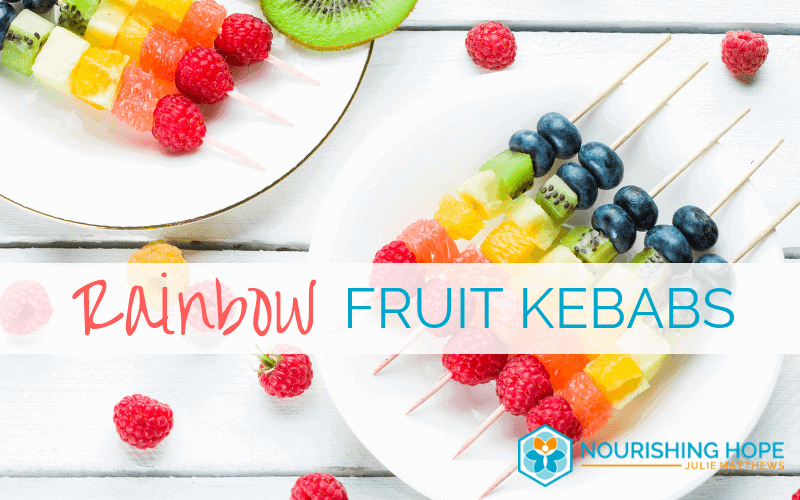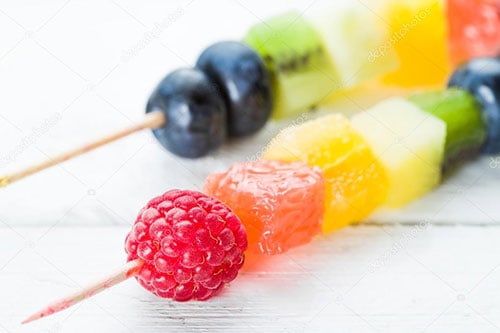
For holidays, kids are often looking for treats. And those are usually in the form of sugar.
Fortunately summer holidays like 4th of July and Labor Day are the perfect time for a healthy fruit based dessert. And nothing is more pure than fresh fruit.
So this holiday try Rainbow Fruit Kebabs.
They are easy, delicious, beautiful… and healthy.
Kids love things “on a stick,” so fruit kebabs are always a hit in my home.
My daughter loves making the kebabs for us. She can cut and skewer the fruit herself. And she loves making them. She even enjoys the process of going to the grocery store and helping plan and pick out the fruit we are going to use. It’s a great learning opportunity for kids to learn about the nutritional value of fresh produce.
For smaller kids that can’t use a knife, cut the fruit for them and supervise while they put the fruit on the skewers. You can find wood skewers at many grocery stores as well as online.
These can also be made with some vegetables like sweet red bell pepper, tomatoes (which are actually a fruit), or jicama. For kids new to eating vegetables, the combination of foods they like (fruit) with unknown foods (vegetables) is a good way to encourage exploration of (and success in eating) vegetables.
Use any fruits you like: such as watermelon, mango, berry, or melon. For those on a low salicylate diet, use compliant fruit (such as: pear, mango, golden delicious apples, or whatever works for your child).
Making them rainbow colored is so fun. People of all ages love them. And they are filled with nutrients. The colors in fruits and vegetables are derived from pigments natural in plants that provide phytonutrients.
Here are some corresponding colors and their nutrient counterpart:

Anthocyanins: Anthocyanins produce the blue, purple, red color found in berries and grapes. Anthocyanin foods contain antioxidants that support health.
Lycopene: Lycopene is a carotenoid found in tomatoes. Studies show lycopenes have a positive effect on heart health.
Beta-carotene: The orange/yellow color in many fruits and vegetables. Humans convert beta-carotene to
vitamin A. Vitamin A assists with growth and development and vision. It is also very important for a healthy immune system: specifically for regulatory T cells, which help prevent an immune response against “self” (i.e. an autoimmune response).
Lutein: Green and yellow plants produce lutein. Lutein is concentrated in the macula of the retina in the eye of humans and plays an important role in vision and eye health.
Zeaxanthin: is a compound very similar to lutein, which gives red bell peppers their orange and red color. Being the same chemical structure (with a different double bond) as lutein, it has similar benefits for the eyes.
Red fruit:
Watermelon, strawberries, raspberries, cherries (pitted), cherry tomatoes
Orange fruit:
Mango, cantaloupe, apricots, peach, nectarines, papaya, orange, grapefruit, sungold cherry tomatoes
Yellow fruit:
Golden raspberry, pineapple, banana,
Green fruit:
Green grapes, kiwi, honeydew melon
Blue fruit:
Blueberries
Purple:
Blackberries, red grapes, concord grapes, plums
Fruit also contains many other vitamins and minerals such as vitamin C, folate, potassium, magnesium, and calcium. One of the best nutrients fruit contains is fiber. Fiber helps keep our good bacteria healthy and improves digestion.
Assembling Fruit Kebabs
 Wash fruit.
Wash fruit.
Place fruit on skewers, either whole or chopped (but be sure to remove pits and seeds).
I prefer bamboo skewers around 10-12 inches long, but any type and size will do.
Arrange on plate with a dipping sauce in the center. You can also take half a cantaloupe (placed round/skin side up) and poke skewers into melon to arrange kebabs in a creative manner.
Dipping Sauces
A dipping sauce can make it fun and nutritious.
Add some protein and fat for a more hearty treat, with a chocolate-nut butter dipping sauce.
Or add some probiotics with a (dairy-free) yogurt dipping sauce
Yogurt Dipping Sauce
GFCF/ SCD/GAPS/Paleo
This dipping sauce supplement probiotics and is refreshing on a hot day (as long as you have a way to keep it cool when storing it).
Ingredients
1 cup of non-dairy yogurt
1 cup of fresh or frozen ORGANIC strawberries, peaches or other fruit
1-2 Tablespoons raw honey
Directions
Puree fruit in a blender and add a splash of milk (enough to get it to spin) and honey. Add the yogurt and blend gently to mix.
Place chucks of fruits and vegetables on a bamboo skewer.
Serve sauce in a fun bowl. Place skewers on plate with bowl of dipping sauce in the center.
Chocolate Sunflower Seed Butter
GFCF, SCD/GAPS, Paleo
To make SCD/GAPS use honey.
This is similar to a Nutella-style butter but nut-free and more dip’able.
Start with sunflower butter, you can make this or buy it.
1 cup Sunflower butter
1 Tablespoon cocoa powder
Stevia, honey or other sweetener
3 Tablespoons non-dairy milk
Mix 1 cup of sunflower butter with 1 Tablespoon of unsweetened cocoa powder. Add sweetener as desired such as: 5 drops of stevia or 1 Tablespoon of honey or other sweetener. Melt on stove, add 3 Tablespoons of non-dairy milk to make it more dip’able.



0 Comments